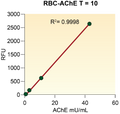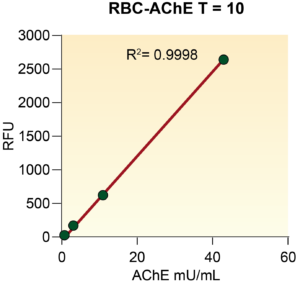Ships: 1-2 business days
AChE100-2: 100 Tests
Part# 3042: Component A: Detection Reagent Diluent, 5.5mL x 1 (-20C)
Part# 3043: Component B: Coupled Enzyme Reagent, 5.5mL x 1 (-20C)
Part# 4016: Component C: Detection Reagent, 1 Vial (-20C)
Part# 3011: Component D: 5X Reaction Buffer x 1 (-20C)
Part# 7012: Component E: Acetylcholine x 1 (-20C)
Part# 6020: Component E: Reg Blood Cell Acetylcholinesterase x 1 (-20C)
AChE100-3: 500 TestsPart# 3042: Component A: Detection Reagent Diluent, 5.5mL x 5 (-20C)
Part# 3043: Component B: Coupled Enzyme Reagent, 5.5mL x 5 (-20C)
Part# 4016: Component C: Detection Reagent, 5 Vials (-20C)
Part# 3011: Component D: 5X Reaction Buffer x 5 (-20C)
Part# 7012: Component E: Acetylcholine x 5 (-20C)
Part# 6020: Component E: Reg Blood Cell Acetylcholinesterase x 5 (-20C)
AChE100-3: 500 Tests
Product Specific References
| PMID | Publication |
| 20177375 | Leonard, S.T., et al. 2010. Gonadal hormones modulate the potency of the disruptive effects of donepezil in male rats responding under a nonspatial operant learning and performance task. Behavioral Pharmacology, 121-34. |
| 21274871 | Zhao, Y., et al. 2011. Acetylcholinesterase, a key prognostic predictor for hepatocellular carcinoma, suppresses cell growth and induces chemosensitization. Hepatology, 493-503. |






